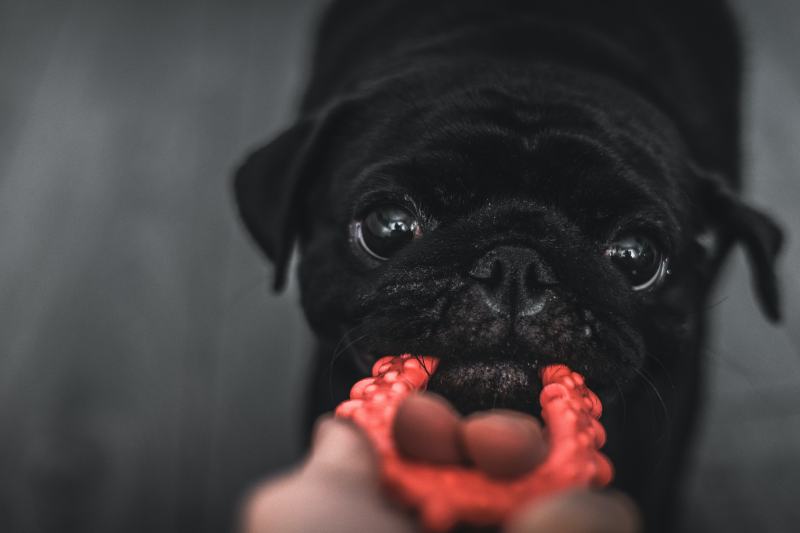In this article
Pugs are wonderful, affectionate, and charming companions, so it’s no surprise that you’d want to share all of life’s adventures with them, including trips to the beach or splashing around in your backyard pool.
Don’t throw your pug into the water just yet. Yes, Pugs are able to swim, but they haven’t been bred for it, so they have limited swimming abilities. Keep reading to learn more about your Pug’s swimming skills and how you can help them enjoy the water safely.

Pugs Know the Doggy Paddle, But…
All dogs, including Pugs, are born with the instinct to paddle their paws when they’re in water. This doesn’t automatically make them good swimmers.
Some breeds are literally born to swim.1 For instance, Labrador Retrievers were bred to retrieve waterfowls for hunters. Newfoundlands were trained for water rescue, while Portuguese Water Dogs helped fisherfolk by herding fish into fishing nets, retrieving equipment lost in the water, and couriers between boats.
As for Pugs? Not so much. Technically, Pugs can swim and paddle if they have to. Unfortunately, they won’t last long in the water before needing to be rescued. Due to being flat-faced dogs and at a higher risk of brachycephalic obstructive airway syndrome (BOAS), Pugs often suffer from respiratory difficulties and reduced exercise tolerance, which can further hinder their ability to swim safely.


Why Pugs Aren’t Strong Swimmers
Everything that makes Pugs so cute, i.e., their smushed faces, short legs, and stocky but compact body, hamper their swimming ability. Here are some reasons why.
1. Their Short Snouts Make Breathe Difficult
Pugs are a brachycephalic breed, which means they have short, flat faces, and compacted, sometimes obstructed airways. This anatomical trait already makes breathing a challenge on dry land.
In water, Pugs with brachycephalic obstructive airway syndrome must work even harder to breathe, which can further compromise their ability to stay afloat.

2. Their Short Legs and Body Shape Don’t Help
Pugs have a stocky, elongated body with very short legs. They lack the streamlined form of natural swimmers like Labrador Retrievers, and they’re unable to maintain proper swimming posture. Their short legs also don’t provide the same propulsion as longer-legged breeds, requiring more effort to move through the water or even just stay afloat.
3. They Tire Out Easily
If you’re looking for a lap dog who’d rather nap than go to the dog park, you’ll love having a Pug in your life. But if you want an active dog who can join you in outdoor adventures (including swimming), you may want to look into another breed.
Swimming is physically demanding, requiring significant oxygen intake, and unfortunately, a Pug’s anatomy isn’t well-suited for that level of exertion.


Keeping Swim Time Safe for Pugs
With that said, you can still take your Pug swimming as long as you observe these precautions:
- Use a life jacket: A canine life jacket will provide extra buoyancy, helping your Pug stay afloat and reducing the risk of drowning. Double-check that it fits them perfectly, or they can slip out of the life jacket.
- Swim when it’s cool outside: Due to their respiratory issues and difficulty cooling down effectively, Pugs tend to overheat. Never take them swimming when it’s hot out. Go early in the morning or late in the afternoon. Better yet, swim in a spot where there’s shade.
- Keep swim sessions short: Your Pug will be tired sooner than you think. Don’t wait until they look exhausted – take regular breaks so they can recover and rest.
- Monitor their breathing: Watch your Pug for signs of labored breathing or excessive panting, which may indicate overexertion.
- Always keep them close: Supervise your Pug while they’re in or around water. Consider attaching a short leash to their life jacket so you can pull them in when the waves get too high, or the currents get too strong.
- Rinse off after swimming: Chlorine from pools or salt from seawater can irritate your Pug’s sensitive skin and eyes. Rinse them off thoroughly with clean water after swimming.
- Dry their skin folds: After swimming, make sure to dry your Pug’s skin folds thoroughly to prevent excess moisture, which can lead to skin infections.
Alternatives to Swimming for Pugs
If your Pug isn’t keen on swimming, there are other ways for them to enjoy the water:
- Sprinklers: Got a sprinkler in your yard? Turn it on and let your Pug run around and cool off in the mist.
- Wading pools: Fill up a shallow kiddie pool and let your dog paddle around to their heart’s content.
- Canine splash pads: Splash pads are shallow plastic platforms with built-in water jets. It’s like a shallow pool and a sprinkler in one!

Conclusion
Pugs may not be the strongest swimmers, but they don’t have to miss all the water fun. Keep them safe by having them wear a life jacket and giving them frequent breaks during swim time. If you’d rather keep them on land, consider getting them a splash pad or kiddie pool instead!
Featured Image Credit: BLACK LEMON, Shutterstock




















